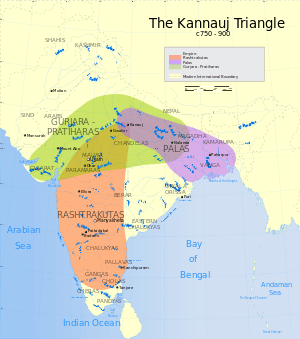Tripartite Struggle

The Tripartite Struggle for control of northern India took place in the ninth century. The struggle was between the Pratihara Empire, the Pala Empire and the Rashtrakuta Empire.[1]:20
Towards the end of the successor of Nagabhata II, successfully attacked Kanauj and established control there. This was short-lived as he was soon after defeated by the Rastrakuta ruler, Govinda III. Howehe Rastrakutas also formed a matrimonial relationship with the Gangas and defeated the kingdom of Vengi. By the end of the 9th Century the power of the Rastrakutas started to decline along with the Palas. This was seen as an ideal opportunity by the feudal king Taila II who defeated the Rastrakuta ruler and declared his kingdom there. This came to be known the Later Chalukya dynasty. Their kingdom included the states of Karnataka, Konkan and northern Godavari. By the end of the tripartite struggle, the Pratiharas emerged victorious and established themselves as the rulers of central India.
History
Not much is known about the kingdom of the Kannauj after Emperor Harsha's death in 647 AD resulting in a great confusion due to the absence of his heirs. Kannauj came for a short period under the hands of Arunasva who attacked Wang Hstian-tse who came to the court of king Harsha as ambassador of the Chinese emperor Tai-tsung. However Wang Hstian-tse succeeded in capturing Arunasva who was taken back to China to spend his days in attendance on the Tang Emperor.
About AD 730, Yashovarman established a kingdom at Kannauj. His invasion of Gauda (Bengal) formed the subject of the Prakrit poem Gaudavaho (Slaying of the king of Gauda), composed by his courtier Vakapatiraja in the 8th century.
After Yashovarman, three kings — Vijrayudha, Indrayudha and Chakrayudha — ruled over Kannauj between close of the 8th century till the 820s. Talking advantage of the weakness of these Ayudha rulers and attracted by the immense strategic and economic potentialities of the kingdom of Kannauj, the Gurjara-Pratiharas of Bhinmal (Rajasthan), the Palas of Bengal and Bihar and the Rashtrakutas of the Manyakheta (Karnataka) fought against each other. This tripartite struggle for Kannauj lingered for almost two centuries and ultimately ended in favour of the Gurjara-Pratihara ruler Nagabhata II who made the city the capital of the Gurjara-Pratihara state, which ruled for nearly three centuries.
References of ars
- ↑ Sen, S.N., 2013, A Textbook of Medieval Indian History, Delhi: Primus Books, ISBN 9789380607344
- Majumdar, Ramesh Chandra (1977) [1952], Ancient India (Reprinted ed.), Motilal Banarsidass, ISBN 9788120804364